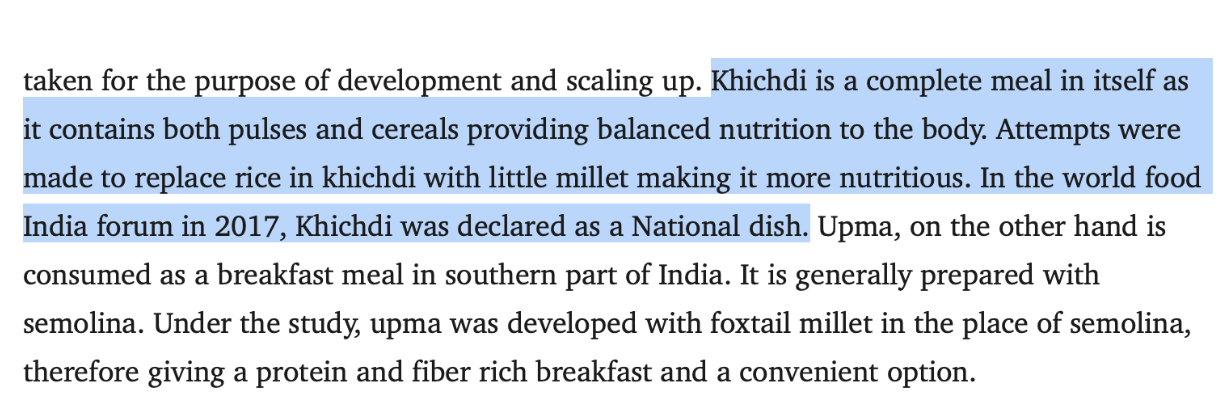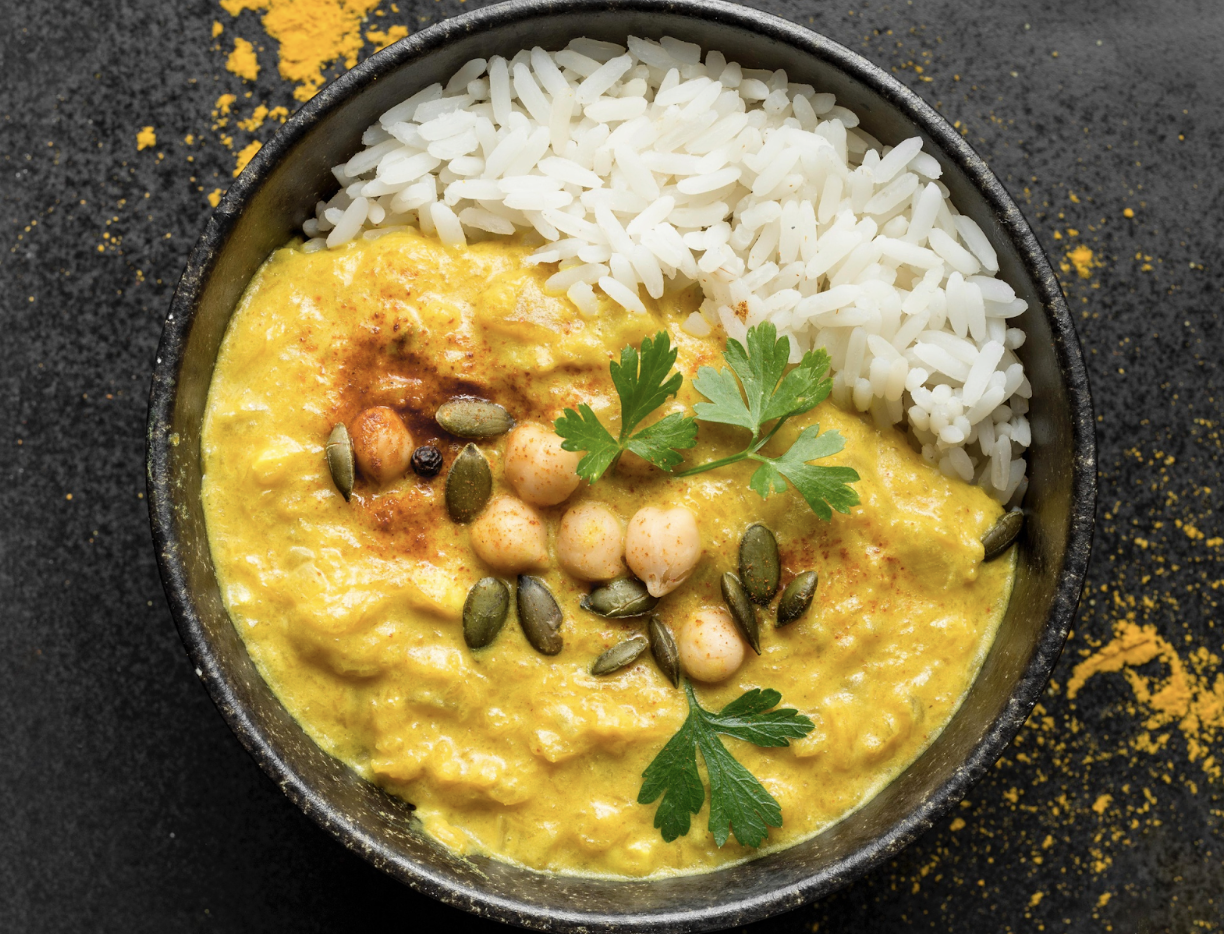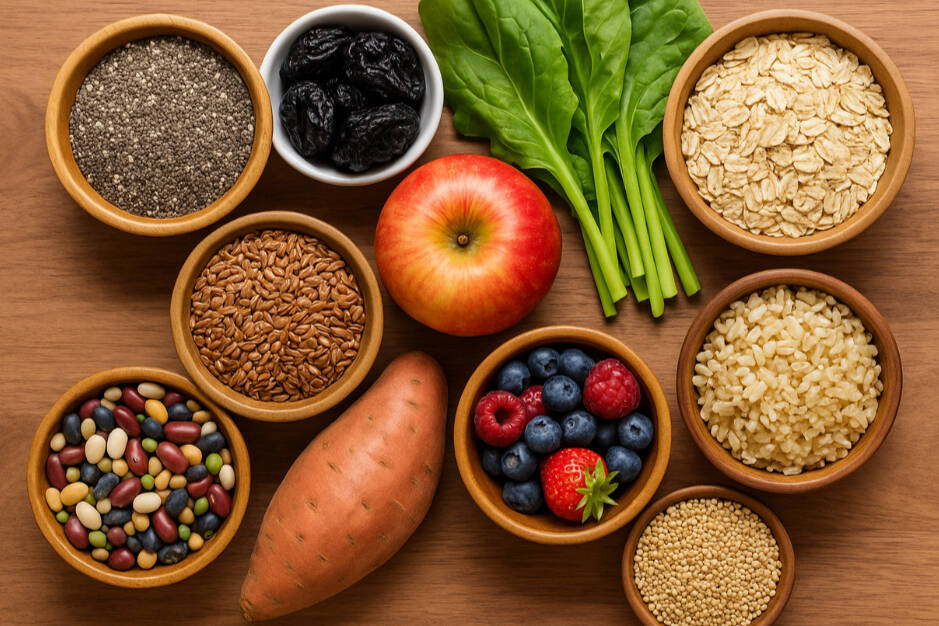There’s something almost magical about a bowl of kadhi khichdi.
It’s the kind of food that doesn’t just fill your stomach—it speaks to your soul.
So, when a rare opportunity came a few months ago, we received a humbling invitation to curate a special menu inspired by our Hon’ble Prime Minister Shri Narendra Modi Ji, rooted in Indian superfoods and lifestyle science.
The Bharat Dish and Lifestyle Tips were to be unveiled at the NXT Conclave 2025, and we had just a few hours to make it happen.
And when we asked ourselves, “What dish could represent this spirit the best?”, the answer was immediate:
Kadhi and Khichdi.
Because kadhi khichdi isn’t just food.
It’s tradition.
It’s nourishment.
It’s rest.
It’s wisdom.
It’s Bharat in a bowl.
Download the Bharat Dish and Lifestyle Tips Booklet Here
What is Kadhi Khichdi?
For generations, kadhi khichdi has been the go-to in Indian households whenever digestion needs support or the body calls for simplicity.
Let’s know why?
Khichdi: The Intelligent One-Pot Meal
Khichdi is a combination of rice and lentils, usually moong dal, cooked with A2 cow ghee, cumin, and a pinch of turmeric. It’s soft, mildly spiced, and deeply nourishing. But it’s more than just ‘comfort food.’
- Easily digestible: Moong dal is one of the lightest lentils on digestion. When pressure-cooked with rice and minimal spices, it allows the gut to rest while still receiving essential nutrients.
- Complete protein: Together, rice and dal form a complete amino acid profile, giving the body clean energy without overburdening the system.
- Gut-friendly fats: A touch of A2 cow ghee not only enhances taste but also provides butyric acid, a short-chain fatty acid that fuels the cells lining your colon.
- Minimal residue: For people struggling with bloating, gas, or IBS symptoms, khichdi serves as a low-residue meal that doesn’t irritate the gut lining.
In many traditional systems, khichdi is considered a sattvic meal—light on the body, calming to the mind, and balancing to the doshas. But it’s not complete without its partner.

Kadhi: The Cooling, Probiotic Powerhouse
Kadhi is a spiced yogurt-based curry made with besan (gram flour), ginger, turmeric, and sometimes tempered with curry leaves, mustard seeds, and ajwain. While it’s known for its signature tang, kadhi is deeply functional when it comes to digestion:
- Probiotic-rich: Fermented curd, especially when made at home, contains live cultures that support gut flora.
- Cooling effect: Kadhi’s sour and spiced profile helps cool inflammation in the digestive tract, especially when you’ve had too many heating or acidic foods.
- Natural digestive aid: Spices like ginger, hing, ajwain, and mustard seeds improve bile flow, enhance enzyme secretion, and reduce gas formation.
- Satiety without heaviness: Kadhi adds volume and flavor to your plate, keeping you full without weighing you down.
When paired together, kadhi khichdi becomes a complete gut-soothing system:
Khichadi grounds and nourishes. Kadhi cools and cleanses. Together, they restore balance, but best avoided if you’re lactose intolerant, as kadhi is made with yogurt.

Why Kadhi Khichdi Is the Perfect Digestive Reset
Here’s why more and more people are looking back to kadhi khichdi as a regular part of a gut-supportive lifestyle:
- It’s Gentle, Yet Nutrient-Dense
When your digestion is off, heavy foods like meats, grains with high anti-nutrient content, or cold salads can further slow things down. Kadhi khichdi is warm, semi-solid, and low in fiber roughage, which allows your digestive system to function without struggle, while still receiving key vitamins, minerals, and clean protein.
2. It Supports Gut Microbiome Balance
Kadhi, with its fermented dahi base, supports microbial diversity. Meanwhile, khichdi supplies prebiotic starches, especially when cooled and reheated, helping feed your beneficial gut bacteria.
3. It Helps Manage Inflammation
Spices like turmeric (curcumin), ginger, and ajwain are scientifically backed for their anti-inflammatory properties. Add a dollop of A2 ghee, and you’re feeding your gut with butyrate-producing fats that calm the gut lining.
4. It Supports Energy Efficiency
Digestion uses up a lot of energy. When you eat something as efficient as kadhi khichdi, your body uses less energy to break it down, freeing up that energy for other functions like immunity, cellular repair, and even mental clarity.

How to Personalize Kadhi Khichadi for Your Bio-Individuality
One of the most beautiful aspects of kadhi khichdi is its adaptability. It isn’t rigid or one-size-fits-all. Instead, it flows with your unique needs—your constitution, your health goals, your season of life.
Here’s how you can tweak and tailor this humble dish to match your body’s bio-individuality:
1. Add Gut-Loving Veggies (When You Can Tolerate Fiber)
If your digestion is stable and you’re looking to increase fiber gently, add well-cooked vegetables like:
- Bottle gourd (lauki)
- Pumpkin
- Carrot
- Zucchini
- Spinach (small amounts)
These vegetables are low in FODMAPs (fermentable oligosaccharides, disaccharides, monosaccharides and polyols) and easy on the gut, especially when chopped fine and cooked till soft. They also add diversity to your plate without disturbing the dish’s lightness.
Note: Avoid raw vegetables or cruciferous veggies like broccoli and cauliflower when your digestion is weak or you’re bloated.
The Good Old Indian Staple: Download Team Luke’s FREE Khichdi Cookbook Here
2. Choose the Right Grain for Your Body Type
- White rice: Great for those with poor appetite, children, or anyone needing quick digestibility.
- Brown rice or millets: Suitable for diabetics or those managing weight, but only when digestion is strong. Soak overnight and cook until very soft.

- Broken rice (ukda chawal): A gentle in-between—easy to digest, yet less spiking for blood sugar.
Remember, the point of kadhi khichdi is to be easy on the gut. So even if brown rice is ‘healthier’ by common standards, it may not be right for you in this context.
3. Upgrade Your Fats with Intention
- Use A2 cow ghee in khichdi to add flavor and support the gut lining with butyric acid.
- Add cold-pressed mustard oil or coconut oil to the kadhi tempering if you’re in warmer regions.
- Keep it minimal, just enough to catalyze digestion, not overwhelm it.
4. Season Smartly with Digestive Spices
Your spice box is your pharmacy. Use it wisely.
In khichdi:
- Jeera (cumin) – stimulates digestive fire
- Hing (asafoetida) – relieves gas and bloating
- Turmeric (haldi) – supports gut barrier function
In kadhi:
- Ginger (Adrak) – warms digestion and supports bile flow
- Carom Seeds (Ajwain) – breaks down stubborn proteins and fats
- Curry leaves – antioxidant and soothing for gut lining
- Mustard seeds (Sarso Ke Beej)– stimulate enzyme release
If you tend to feel cold easily or have a sluggish digestion, go heavier on warming spices. If you tend to overheat or have loose stools, keep the tempering light.
5. Adapt Kadhi to Suit Your Gut
- Use homemade curd that’s not too sour, fermented just right.
- If you’re lactose-intolerant, you can either use diluted buttermilk (chaas), which is easier on the gut and lower in lactose, or choose to make our non-dairy kadhi using plant-based yogurt alternatives, so you can still enjoy the comfort and balance of kadhi khichdi without the discomfort.
- For people with weak digestion, strain kadhi to remove fibrous residue and make it smoother on the gut.
6. Pair with Simple Lifestyle Habits
Kadhi khichdi works even better when paired with small lifestyle practices, like:
- Mindful eating: Sit down, unplug, chew slowly.
- Post-meal walk: A 10-minute stroll can aid digestion and blood sugar balance.
- Deep breathing: Three to five slow breaths before your first bite calms the nervous system and enhances digestive secretions.
- Ajwain water or jeera tea post meal: Especially useful if you still feel heavy or gassy after.
When Is the Best Time to Eat Kadhi Khichadi? Timing Matters More Than You Think
Traditional Indian systems like Ayurveda, and now even modern circadian rhythm science, both agree: digestion follows the rhythm of the sun.
Your gut’s enzymatic activity, bile secretion, and metabolic fire (agni) are not constant, they fluctuate through the day.
So, where does kadhi khichdi fit in?
Let’s look at the best times to embrace this soulful, gut-supportive meal.
Lunch: The Ideal Time for Kadhi Khichadi
If you’re looking for optimal digestion and nutrient absorption, midday is your best bet. That’s when:
- Digestive fire is strongest
- Enzymes are most active
- The body can handle fermented foods like kadhi without gas or discomfort
Kadhi khichdi for lunch is especially helpful when:
- You’re feeling bloated, heavy, or sluggish from previous meals
- You need a gentle, balanced meal that won’t lead to a post-lunch crash
- You’re in a cleansing phase or post-festival reset
Pair it with a short post-meal walk in the sun for improved digestion and vitamin D synthesis.
Dinner: Keep It Light, Keep It Smart
Eating kadhi khichdi for dinner can also be beneficial, but with a few tweaks:
- Reduce portion size
- Make the kadhi thinner (more water, less besan)
- Skip heavy tempering or spicy tadkas
- Eat early—preferably before 7:30 pm
This helps the body wind down and allows the digestive system to complete its work well before bedtime. The soothing nature of kadhi and the lightness of khichdi make it a perfect comfort meal, especially on nights when you’re feeling emotionally or physically drained.
What About Breakfast or Snack Time?
Traditionally, kadhi khichdi isn’t a breakfast item, but that doesn’t mean it can’t be. In fact, for people with poor morning appetite, gastritis, or those doing early meals in a circadian fasting plan, a mid-morning bowl of thin khichdi with plain kadhi could be a soothing and effective way to start the day.
Likewise, in senior citizens or those with sensitive digestion, even a small bowl as a light evening snack (around 5–6 pm) works wonders.
Best Days to Eat Kadhi Khichdi
There are certain days where your body just calls for something light, grounding, and easy. Listen to that call. Here’s when kadhi khichdi shines the most:
- After festivals, weddings, or long travels
- When you’re fasting and breaking your fast
- On days of low appetite or fatigue
- During monsoons or seasonal transitions
- When recovering from digestive overload or food poisoning
- Before sleep-heavy nights (post cheat meals, parties, or stress eating)
How Often Should You Eat Kadhi Khichdi? Plus Simple Rotation Tips for Gut Support
Kadhi khichdi is one of those rare dishes that is both calming and complete. It gives your gut the break it needs, while still nourishing your body. But like all good things, balance is key.
-
The 3-1 Rule: A Gentle Kadhi Khichadi Rhythm
For most people, two to three times a week is a sweet spot. Here’s a sample rhythm you can follow:
- Day 1: Kadhi khichdi for lunch after a weekend of heavy meals
- Day 3: Kadhi khichdi for dinner post-travel or late night
- Day 6: Kadhi khichdi as a reset after celebrations or dining out
This spacing ensures you benefit from its gut-soothing properties without creating food fatigue or nutritional monotony.
-
Smart Rotations to Keep It Fresh and Functional
To avoid repetition and give your taste buds variety, try these simple rotations without losing the core benefits of kadhi khichdi:
Khichadi Base Variations
- Use split green moong dal, toor dal, or masoor dal for variety
- Alternate grains: white or brown rice, red rice, broken wheat, or soaked millets
- Add slow-cooked veggies for texture: ash gourd, pumpkin, bottle gourd, spinach
Kadhi Variations
- Switch tempering styles, try curry leaves and coconut oil (South Indian style), or add a touch of fenugreek seeds and ginger (Gujarati style)
- For summer, make kadhi thinner and tangier; for winter, go slightly richer with a warming tadka
Accompaniments That Support Digestion
- Pair with roasted papad and jeera water for enhanced digestion
- Add a side of sautéed greens with garlic if you want to boost mineral intake
- Serve with steamed methi leaves or a teaspoon of pickle to spark digestive juices
Not Just a ‘Sick Day’ Food—A Smart Day Choice
Kadhi khichdi is generally safe for all age groups, including:
- Children with weak appetite or recovering from digestive issues
- Seniors with low chewing capacity or sluggish digestion
- Women during menstruation or perimenopause (helps cool inflammation and ease bloating)
- Individuals managing stress, anxiety, or sleep issues (the meal is naturally grounding)
If you’re on a high-protein or low-carb plan, you may want to balance portions or add a protein-rich side. But otherwise, this meal stands tall as a complete, intelligent choice.
Final Thoughts: The Wisdom of Simplicity
In a world full of food fads, powders, and protocols, kadhi khichdi reminds us of the power of simplicity. It’s not a cleanse. It’s not a treatment. It’s a gentle, intelligent way to support your gut, calm your mind, and reclaim your energy.
And as part of the Bharat Dish and Lifestyle Tips, inspired by the deep wisdom of our land and our Hon’ble Prime Minister Shri Narendra Modi Ji, it stands as a timeless example of how Indian food, when eaten with intention, can become medicine for daily living.
Download the Bharat Dish and Lifestyle Tips Booklet Here
So whether you’re feeling off, overwhelmed, or just want to return to the center…
Serve yourself a warm bowl of kadhi khichdi. Sit down. Breathe. Chew slowly. Let tradition do its work.
ALSO WATCH
Disclaimer: This content is intended for educational and informational purposes only and does not replace professional medical advice. Always listen to your body and consult a qualified healthcare provider before making any significant changes to your nutrition or lifestyle.
Managing gut health challenges can often feel overwhelming, but it doesn’t have to be that way.
Our Gut Care Program offers a supportive and personalized approach to help you work toward that balance, with expert guidance, consistent communication, and thoughtful program design tailored to your needs.
Schedule a one-on-one consultation with our experts by calling us at 1800 102 0253 or emailing us at [email protected].
Team Luke
Start Your Wellness Journey
Feeling inspired to take the next step in your wellness journey? Connect with us to explore how our tailored programs can support your health journey. Your transformation is just a conversation away.



